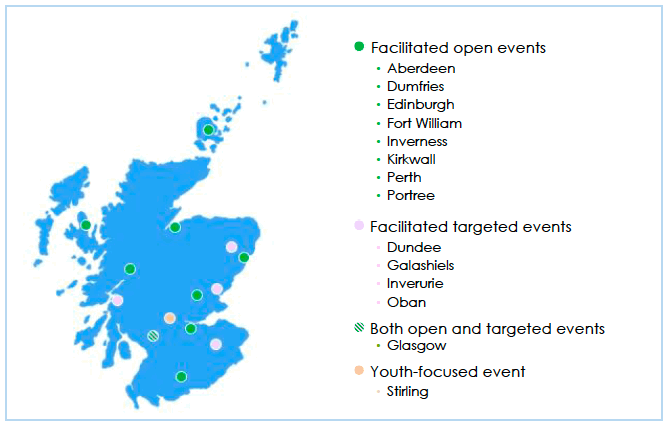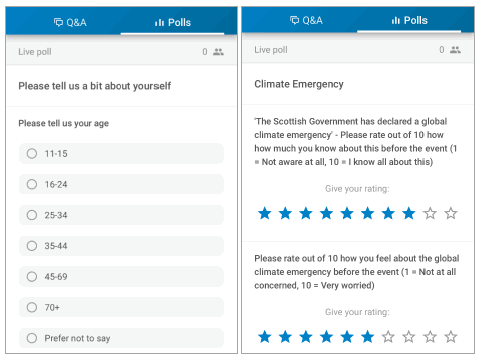Big Climate Conversation: report of findings - technical annex
Annex which accompanies the main findings report from the Big Climate Conversation providing more information about the design and delivery of the public engagement process and the analysis of participant responses.
Strand 1: Facilitated Workshops (JUL - NOV 2019)
The Big Climate Conversation began with a series of workshops, which were supported and facilitated by a non-governmental organisation. Following a competitive procurement process, the Scottish environmental charity, Keep Scotland Beautiful (KSB) were appointed to deliver these workshops.
KSB ran workshops in different locations around Scotland. Locations were selected to include a range of cities, towns and rural areas, including the islands (see Figure 1).
Three different types of workshops were facilitated:
i. 9 x large, ‘open-audience workshops’. Attendance was open to any individual who was interested in participating.
ii. 1 x ‘youth workshop’. Attendance was restricted to participants aged 11 – 26 years old to ensure that the voices of young people were represented.
iii. 5 x focussed ‘targeted-audience workshops’. Attendance was incentivised to enable participants with lower pre-existing engagement in climate change conversations to be intentionally recruited via a screening questionnaire.
With the exception of the youth event, all workshops were held at 17:30 – 19:30 on weekday evenings to enable people in regular employment to attend. The youth event was held from 13:00 – 15:00 during school summer holidays. Refreshments were provided at all workshops.

Figure 1: Locations of facilitated workshops
Workshop format
All three types of workshops followed a very similar format. Each event was two hours long and was run as a guided conversation between participants who were seated around tables in groups of up to 12 people.
All the events began with a welcome and introduction, which explained the purpose of the event and how the data would be used. Following this introduction, a series of discussion topics and questions were presented to the participants by a lead facilitator positioned at the front of the room. Slides and activity cards used during the workshops are provided in Appendix 1. The topics and questions presented were developed to provoke discussion based on suggested solutions from experts such as the Committee on Climate Change. Not all suggested actions are current Scottish Government policy positions.
The activities and discussion topics used in the workshops were designed to gather the following information from participants:
- Levels of understanding and concern about the global climate emergency.
- Opinions on the ambition of the Scottish Government’s 2045 target for reaching net-zero emissions.
- Views on some of the biggest societal changes required to reach net-zero emissions and the challenges to be addressed.
- Perspectives on how to prioritise actions to address the global climate emergency and achieve net-zero emissions.
After each topic or question had been introduced by the lead facilitator, participants were prompted to have a conversation with the people at their table. Additional facilitators were available around the room to answer questions and keep the discussions focussed, if necessary, but these facilitators were not sat at the tables leading the conversations. Halfway through the event, participants were given the opportunity to move tables so that they could have a conversation with different people if they wished, but this was optional.
Format modifications
The content of the workshops was slightly adjusted in response to participant feedback from the first event in Glasgow. Participants found there to be too much emphasis throughout the workshop on individual behaviour change as a solution to tackling climate change. Therefore, the discussion topics and questions were reframed in future workshops to encourage participants to consider societal change more broadly, including actions by government and business as well as individuals and communities.
The youth event followed the same basic structure as the other events, addressing the same overarching questions. However, this event was led by a facilitator with specific experience in working with young people. She made minor adjustments to the language to ensure that discussion topics were appropriate for a younger audience. For example, ‘Introduce a frequent flyer tax’ was reworded as ‘Pay more if you fly more’ and ‘Incentivise tree planting’ became ‘Plant more trees’. The facilitator also enhanced the interactivity of some of the activities to more directly encourage the young people to move around the room and discuss their ideas with different participants.
Modifications were also made for the targeted-audience workshops to ensure the content was appropriate for an audience with little or no prior knowledge of climate change. In addition, the final activity, a ‘readiness ruler’ which had participants rank how prepared they were to make lifestyle changes, was omitted to allow more time to discuss challenges to change and how these challenges could be overcome.
Data collection
Once participants had finished each section of the workshop, they were given time to record their views, either by writing in a specially-designed workshop booklet or by using a web-based tool via their mobile phones (www.sli.do). Screenshots of the Slido feedback form are shown in Figure 2 and a copy of the data collection booklet is provided in Appendix 2.

Figure 2: Screenshots of Slido feedback form
Using an online tool such as Slido is useful for giving the participants in the room some ‘real time’ feedback on their answers and views. For example, after participants were asked to share the word they associated with “climate emergency” all of their words were generated into a word cloud which was visible on a screen for participants to see. This enabled participants to see the views of others in the room which helped to create a transparent and participative atmosphere. Slido also has the added benefit of saving significant time in transcribing handwritten data for analysis.
Handwritten booklets were available for participants that didn’t have a compatible mobile phone, or simply preferred to use paper and pen to record their comments. Approximately a third of respondents chose to use the paper booklet. Participants who recorded their answers in booklets generally wrote more, however, not all written answers were legible and therefore some could not be incorporated into the findings.
Recruitment of participants
Each of the three types of workshop were aimed at a different audience and involved a different recruitment procedure.
1. Open-audience workshops (July – September)
These events were designed to allow members of the public who were interested in being part of The Big Climate Conversation to have an opportunity to participate in a face-to-face workshop.
The events were widely advertised through social media, primarily via the @ScotGovClimate and @KSBScotland Twitter accounts, as well as other Scottish Government social media platforms. Additionally, a ‘Call to Action’ email was sent to 46 organisations, located in each of the areas where a conversation event was being held, encouraging them to promote participation among their communities.
Between 75 and 135 tickets were available for each event (depending on the venue capacity), and participants were asked to register to attend online (via Eventbrite). Attendance was free of charge.
Almost all of these events were fully booked in advance, and many events were overbooked in anticipation of a proportion of registered participants not turning up on the day. It was, however, very difficult to predict the drop-out rate of registered attendees as this fluctuated very substantially between events. For example, 91% of registered participants attended the Dumfries workshop, while only 48% attended the Aberdeen workshop (see Table 1). In the end, open-audience workshop attendance ranged from 31 to 98, with an average attendance of 55 people.
| Event | Registered | Attended | % drop out |
|---|---|---|---|
| Aberdeen | 80 | 38 | 52% |
| Fort William | 130 | 65 | 50% |
| Stirling | 60 | 31 | 48% |
| Inverness | 100 | 57 | 43% |
| Edinburgh | 85 | 46 | 39% |
| Perth | 75 | 46 | 37% |
| Portree | 80 | 57 | 29% |
| Glasgow | 135 | 98 | 27% |
| Kirkwall | 55 | 41 | 25% |
| Dumfries | 80 | 73 | 9% |
| Total | 880 | 552 | - |
| Average | 88 | 55 | 36% |
Table 1: Registrations and drop-out rates for each of the open-audience workshops
2. Youth workshop (24th July)
This event was promoted through a range of local and national youth organisations. Additionally, it was promoted on our social media platforms with specification that it was a ‘youth-focused group targeted at participants aged 11 – 26’. The Eventbrite registration was also organised in a way that prevented registration by individuals older than 26 to make sure that all available spaces were reserved for younger participants.
3. Targeted-audience workshops (September – November)
The open-audience events naturally attracted people who were interested in discussing climate change and wanted to share their views with the Scottish Government. As a result, the majority of the participants in these events were already highly engaged in conversations about climate change. (See report of findings for more details on who attended the workshops).
Insights from highly engaged individuals are typically very well informed and therefore incredibly valuable. However, it was also important to hear from people who had been less engaged in these conversations to date, as action to address the global climate emergency will need to involve all members of society.
The targeted-audience workshops were therefore organised with the specific aim of encouraging participation from people with less prior engagement in conversations about climate change. Events were held in five locations: Dundee, Oban, Galashiels, Glasgow, and Inverurie.
Participants were recruited using ‘purposive sampling’[1] through a two-stage process:
- Stage 1: Widespread advertising in the area via social media, posters in places of high footfall and adverts in the local press. People who were interested in attending were invited to register their interest online which involved completing a short screening questionnaire. (See Appendix 3 for screening questions used).
- Stage 2: Selection of participants from the pool of those who had registered. The screening questions were used to identify individuals who appeared to be least engaged in climate change while maintaining demographic diversity (particularly with respect to gender and level of education).
These workshops were designed to be smaller than the open-audience events to enable closer facilitation and greater guidance on discussion topics. Therefore, a maximum of 25 places were available at each event. Unlike the open-audience workshops, participants were offered a £25 cash incentive to attend, which meant that there were very few no-shows on the day.
Recruiting participants for the targeted-audience workshops was challenging. The 2018 Scottish Household Survey found that 65% of adults believe that climate change is an immediate and urgent problem. In March 2019, the BEIS Public Attitudes Tracker found that 80% of the UK population was either fairly or very concerned about climate change. Therefore, there is a relatively small pool of people from which to recruit people who describe themselves as unengaged with this issue of climate change, particularly in areas with smaller populations. In addition, some participants who described themselves as unengaged with climate change in the screening questionnaire were found to still have significant levels of knowledge and/or concern.
Contact
Email: climate.change@gov.scot
There is a problem
Thanks for your feedback